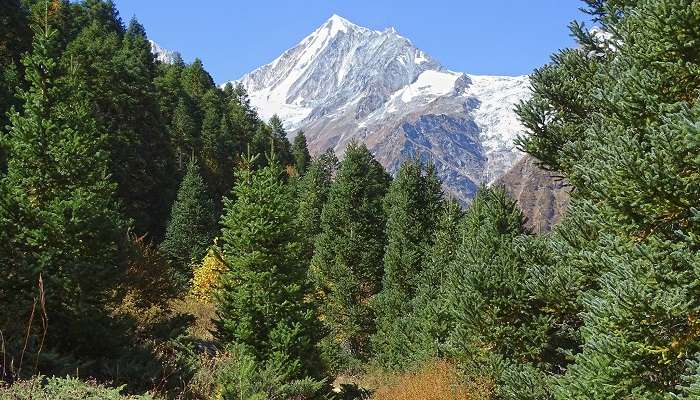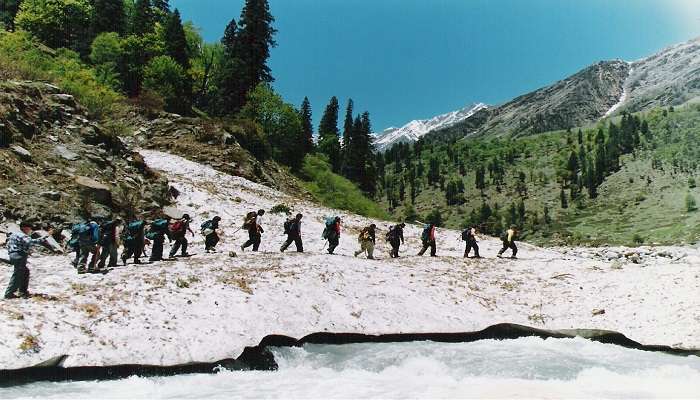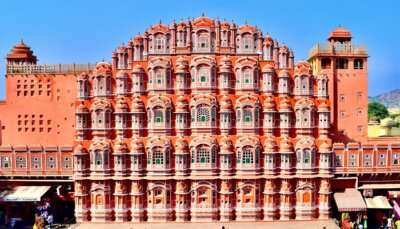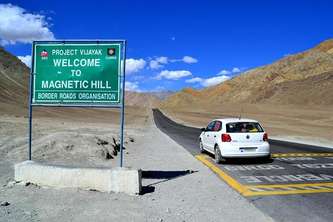Explore The Gangotri National Park To Witness Rich Biodiversity In 2026

Indian wildlife sanctuaries are known for being home to the rarest flora and fauna. Gangotri National Park in the majestic Garhwal Himalayas is no exception with its virgin beauty. It is one of India’s most unscathed wilderness areas, spanning 2,390 square kilometres. Half the region of Gangotri National Park is sacred, with the River Ganga flowing through it, along with its origin, making this park a pilgrimage site and bearing centuries-old temples.
About The Gangotri National Park

Located in the Uttarkashi district, Gangotri National Park is dear to pilgrims and nature lovers. The park is named after Gangotri, a Hindu city notorious for being the source of the Ganga River, which Hindus consider pure. A holy dip in Bhagirathi is essential for pilgrims, as the river, which sprouts from the Gangotri glacier within its precincts, represents Ganga.
Gangotri National Park is between 1,800 and over 7,000 meters above sea level. These extreme elevations contribute to various climates in the park, from subtropical at low and mid-elevations to alpine conditions on mountain tops. During the winter, the park is harsh, with considerable snow from November through April, while summer (May to October) provides more access and a friendlier climate for visitors. It lies on the upper reaches of the River Bhagirathi, one of the main tributaries to the Ganga.
Also Read: Places To Visit In Gangotri
Gangotri National Park’s Culture and Spiritual Significance

As part of the larger Himalayan landscape, it is known for being an ecological asylum and having spiritual and cultural significance. The park is home to Gangotri Temple, a Hindu shrine dedicated to the worship of Ganga and one of the most essential Char Dham pilgrimage sites. In Hindu mythology, it is said that Ganga descended to Earth from heaven at Gangotri. Millions of devotees visit this place for pilgrimage and spirituality, paying obeisance to their ancestors during ceremonies.
The temple, located 3,100 meters above sea level in the Himalayan ranges of Uttarakhand, attracts thousands of pilgrims, especially during the Diwali and Ganga Dussehra festivals. The temple is considered an act of spiritual purification and atonement, with the water cleansing away sins.
Gangotri National Park Flora
Due to the varied altitude and climatic conditions in Gangotri National Park, a wide range of vegetation types flourish. The park’s flora is largely subalpine-adapted, with alpine types also widespread.
1. Subalpine Vegetation

The subalpine zone is filled with coniferous forests at 3,000 to 4,000 meters (10,000 to 13,500 ft). The main species of trees in this zone are:
Conifers: Blue Pine, Silver Fir, Deodar
Broadleaf Trees: Oak (Quercus semecarpifolia), Maple (Acer caesium), and Rhododendron (Rhododendron arboreum)
These trees provide a home to numerous wildlife species and are essential to the region’s ecosystem.
Related Post: Gangotri Glacier Trek
2. Alpine Vegetation

The plant life changes into alpine meadows and scrublands above the subalpine zone. The main characteristics of this zone are:
Alpine Meadows: Known locally as Bugyals, these meadows resemble a lush green carpet with various grasses and herbs. During the spring season, they come alive with millions of flowers.
Shrubs (and Herbs): Juniper, Berberis, and many other Primula and Potentilla species
The alpine zone also harbours a diversity of important medicinal plants, which form critical components of the economy and tradition of local communities.
Gangotri National Park Fauna
Gangotri National Park is home to several rare and endangered species. Its remote and rugged terrain provides a refuge for numerous large mammals, birds, and other wildlife.
1. Mammals

Around 400 species of birds and about fifteen mammals, including:
Snow Leopard (Panthera uncia): Ranked among the top IUCN endangered species, this elusive predator is one of Gangotri National Park’s iconic fauna.
Himalayan Black Bear (Ursus thibetanus): These bears, found in low forested elevations, are important ecologically and culturally.
Blue Sheep / Bharal (Pseudois nayaur): Another snow leopard’s primary prey species, Blue sheep can be seen at higher altitudes.
Musk Deer (Moschus chrysogaster): Known for their scented musk gland, they are shy and rarely seen.
Himalayan Tahr (Hemitragus jemlahicus): These adaptable, nimble-footed ungulates are frequently spotted on and around steep rocky slopes.
Related Post: Places To Visit In Uttarakhand
2. Birds

Gangotri National Park birdlife is also quite interesting, with around 150 bird species recorded. Notable species include:
Himalayan Monal (Lophophorus impejanus): State bird of Uttarakhand
Bearded Vulture (Gypaetus barbatus): Also known as the Lammergeier, this bird can be regularly seen soaring among the park cliffs.
Golden Eagle (Aquila chrysaetos): A severe raptor, the golden eagle is among the largest birds in the park.
Snow Partridge (Lerwa lerwa): Found blending beautifully in the rock terrains of higher altitudes.
The Gangotri Glacier

Gangotri National Park is home to the Gangotri Glacier, one of the largest in the Himalayas. This 30-km-long, several-km-wide glacier is the source of the Bhagirathi River, which later joins with the Alaknanda to form the Ganges, one of the holiest rivers in India.
The trek to Gaumukh (the snout where the Bhagirathi originates) is world-renowned. Gaumukh derives its name from the striking resemblance of the snout to a cow’s mouth. The Gaumukh glacier trek offers spectacular views with peaks visible from Tapovan.
Related Post: Kempty Falls In Mussoorie
Trekking and Adventure Activities
Gangotri National Park offers a delightful source of adventure for both novice trekkers and seasoned climbers. Home to impressive landscapes and mesmerising vistas, you have plenty to choose from on your next visit! The most enjoyed treks and activities include:
1. Gaumukh Trek

The trail takes you to the snout of the Gangotri glacier, the most popular trek in the national park. This 18 km long trek (one way) begins from Gangotri and passes through thick forests, alpine meadows, and rocky terrains. It offers spectacular views of the Bhagirathi peaks and an up-close look at a glacier.
Starting point: Gangotri,
Best Time: May to June and September to October
2. Tapovan Trek

Tapovan is perfect if you are a little adventurous. It is a high-altitude meadow situated beyond Gaumukh. Walking up along the lateral moraine from Bhojbasa is relatively easy compared to the steep and rough terrain a few days before. The base camp is just underneath Mount Shivling. While the trek includes some arduous hops and descents across the glacier, it is considered one of the best methods. Tapovan offers panoramic views and is an excellent spot for photography, especially for nature lovers.
Starting point: Gangotri
Best Time: May to June and September to October
Related Post: Dehradun Zoo
3. Mountaineering and Climbing

Gangotri National Park is a popular destination for mountaineers, offering access to several challenging peaks. Notable peaks for climbing expeditions include Shivling, Bhagirathi, Thalay Sagar and Meru. These peaks are known for their technical difficulty and require advanced mountaineering skills, attracting climbers from around the globe.
Starting point: GMVN rest-house
Best Time: May to June and September to November
Practical Information for Travellers
For those inspired to embark on their journey to Gangotri National Park, here are some practical tips to help you plan your trip:
Best Time to Visit: The ideal time to visit Gangotri National Park is from May to October, when the weather is favourable for trekking and outdoor activities. The park is closed during the winter months due to heavy snowfall.
Permits: Visitors need to obtain permits to enter Gangotri National Park. These can be acquired from the Forest Department office in Uttarkashi or Gangotri.
Accommodation: Options range from basic guesthouses and dharamshalas (pilgrim rest houses) in Gangotri town to camping in designated areas within the park. For a more immersive experience, consider staying in eco-friendly lodges or trekking camps.
Guides and Porters: Hiring a local guide or porter is recommended, especially for longer treks. They know the terrain and can provide valuable insights into the park’s flora, fauna, and cultural heritage.
Preparation: Due to the high altitude, it’s crucial to acclimatise appropriately to avoid altitude sickness. Carry essential supplies, including warm clothing, sturdy footwear, a first-aid kit and sufficient food and water.
Respect the Environment: As visitors, we are responsible for minimising our impact on this fragile ecosystem. Follow the principles of Leave No Trace, avoid littering and respect local customs and wildlife.
You May Also Like To Read: Sahastradhara Resorts
Gangotri National Park is a natural beauty, biodiversity, and cultural heritage treasure trove. Its stunning landscapes, rich flora and fauna, and spiritual significance make it a must-visit destination for nature lovers, adventurers and pilgrims alike. Whether trekking to the Gangotri Glacier, seeking the elusive snow leopard, or simply immersing yourself in the serene environment, Gangotri National Park offers an unforgettable experience. So, plan a trip to Gangotri and explore the beauty of the Himalayas today!
For our editorial codes of conduct and copyright disclaimer, please click here.
Cover Image Credit: Gauravkaintura1234 for Wikimedia Commons
Frequently Asked Questions About Gangotri National Park
What is Gangotri National Park famous for?
Gangotri National Park, best known for its scenic beauty, spiritual significance, and rich bio-diversity, is another protected wildlife ecosystem near the River Ganga's source – the Gaumukh glacier. It has a variety of rare animals, such as the snow leopard, musk deer, and Himalayan tahr.
How to reach Gangotri National Park?
The nearest airport is Jolly Grant in Dehradun, and the railway station in Dehradun. One has to travel up to Dehradun, the capital of the state of Uttarakhand, to get to this National park. It will take another drive to arrive at the gateway town of Uttarkashi to the Gangotri National Park, and an additional drive from this town will take one to Gangotri town, near to the gate of this national park.
Which river flows from Gangotri National Park?
The Bhagirathi River, the source stream of the River Ganga, flows from this national park to the Gaumukh glacier. It is not a large river; the Alakananda is the largest of all the rivers of the Ganga. Several tributaries feed the Main Ganga, which originates from this glacier.
Which is the largest national park in India?
The Hemis National Park in the eastern Ladakh region of Jammu and Kashmir is the largest in India. It is located at a height ranging from 3,300 meters to 6,000 meters. It spans an area of 4,400 sq.km.
How far is the Gangotri trek?
The starting point of the Gangotri pilgrim’s tour is the city of Gangotri. It is a 14-km trekkers roll this ice round and zero. It’s a fascinating journey; its difficulties are as big as its beauty. It also includes a 14 km ashram route and climbing routes TBD 6-7. The further trek to the Tapovans, which are further than Gamuk, extends a difficult additional distance to amateur groups.
People Also Read:
Neora Valley National Park Kumana National Park Nagarhole National Park

With a passion for travelling, and carving beautiful stories of stunning locations I chose my profession as a content writer. The unique blend of creativity and strategy ensures that each narrative takes readers on a journey to their desired destination. With distinct locations and unique vibes, I strive to deliver captivating content that speaks to the hearts of readers.











